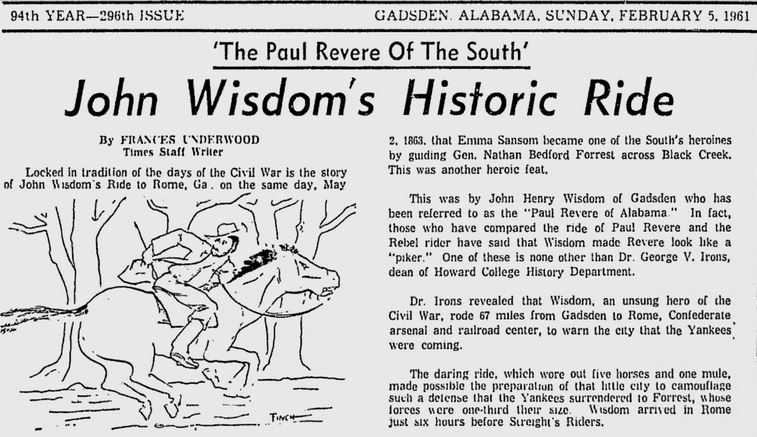As many of us peruse the work and words of Maya Angelou, we thought it fitting to reflect upon the mentality she spent much of her life fighting against. The article below, from 1961 Alabama, celebrates the Lost Cause of the South in a manner very common to publications before the 1980s, ignoring the issue of slavery entirely and glorifying its defenders. In more recent history, stories like that of John Wisdom have been told with greater scholarship and a wider point of view.
The language with which Wisdom’s efforts to preserve the Confederacy is presented reminds us of the ways popular history can be used to reinforce cultural assumptions. Alternatively, we also recall the loyalty of thousands of students and churches to the nonviolent protests and sit-ins that delivered the Civil Rights Movement to the forefront of victory. Equalizing the status of all on buses, in schools, and at lunch counters, the commitment of strong voices like those of Dr. Martin Luther King Jr. and Dr. Maya Angelou brought about a transformation of our society we can all be proud of.
Below is the full story told by Frances Underwood of the Gadsden Times, in February 1961.
‘The Paul Revere of the South’: John Wisdom’s Historic Ride
Locked in tradition of the days of the Civil War is the story of John Wisdom’s Ride to Rome, Ga. on the same day, May 2, 1863, that Emma Sansom became one of the South’s heroines by guiding Gen. Nathan Bedford Forrest across Black Creek. This was another heroic feat.
This was by John Henry Wisdom of Gadsden who has been referred to as the “Paul Revere of Alabama.” In fact, those who have compared the ride of Paul Revere and the Rebel rider have said that Wisdom made Revere look like a “piker.” One of these is none other than Dr. George V. Irons, dean of Howard College History Department.
Dr. Irons revealed that Wisdom, an unsung hero of the Civil War, rode 67 miles from Gadsden to Rome, Confederate arsenal and railroad center, to warn the city that the Yankees were coming.
The daring ride, which wore out five horses and one mule, made possible the preparation of that little city to camouflage such a defense that the Yankee surrendered to Forrest, whose forces were one-third their size. Wisdom arrived in Rome just six hours before Streight’s Riders.
Dr. Irons said that Revere’s ride covered only nine miles and that he was captured by the British before he reached Concord, while Wisdom’s courageous deed hailed a signal victory for the South.
There are very few people living today who can recall that two ferries on the East side of Broad Street served the city of Gadsden and county in the “good old days.” One was just on the north side of the present Broad Street bridge and the other was a short distance to the south. John Wisdom operated the upper ferry, the Wisdom Hotel and a stage line from Gadsden to Jacksonville.

John Henry Wisdom
On May 2, 1863, Wisdom rode his horse and buggy to the east bank and went out into the country on a business mission. When he came back several hours later, his ferryboat was missing. A group of excited citizens on the west bank shouted to him that the Union Army had cut the boat loose and set it downstream. He was told that the Federals were headed for Rome to destroy the Confederate arsenal. He got in his buggy and headed for Rome to warn the citizens there of the impending peril.
According to the Alabama Historical Association, Wisdom found that the Yankees were going the north or shorter side of the Coosa, so he embarked on the south or longer side, and arrived at Rome first, but only because of remarkable determination and perseverance. He traveled 67 miles in 11 hours, 8 1/2 of which he was riding and the rest walking or searching for new mounts.
John Wisdom later moved to Hokes Bluff and, though the members of his family are not there any more, the little town will commemorate his ride during the Centennial.

Hokes Bluff (photo by Jim Felder; posted by Alabama Scenic River Trail)
In June of 1957, the Etowah Historical Society erected a marker on the Coosa River overlooking the spot where the famous old ferry was located and bears an inscription to the heroic deed by John Henry Wisdom. The marker is made of stone from Sand Mountain and has a granite inset, explaining the historical significance.
The marker for Wisdom and the statue for Emma Sansom are placed almost exactly opposite … thus keeping alive the memory that a man and a young girl both were heroic in their own individual ways in the trying days of the Civil War. Both were Gadsdenites, both loved the South and took no thought of danger to themselves. Both lived out their lives to ripe old age never dreaming that what they had done was anything out of the ordinary.









